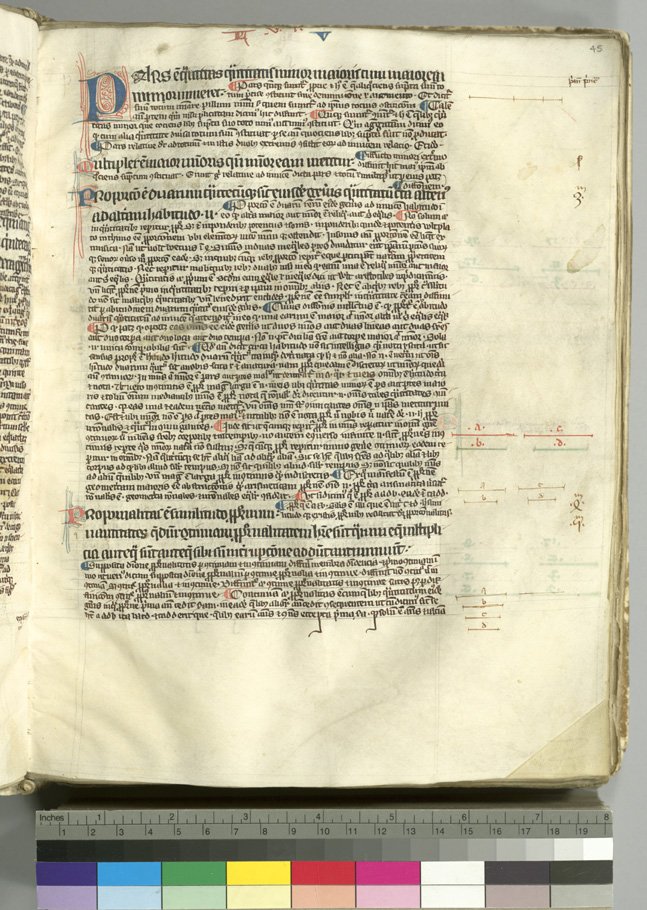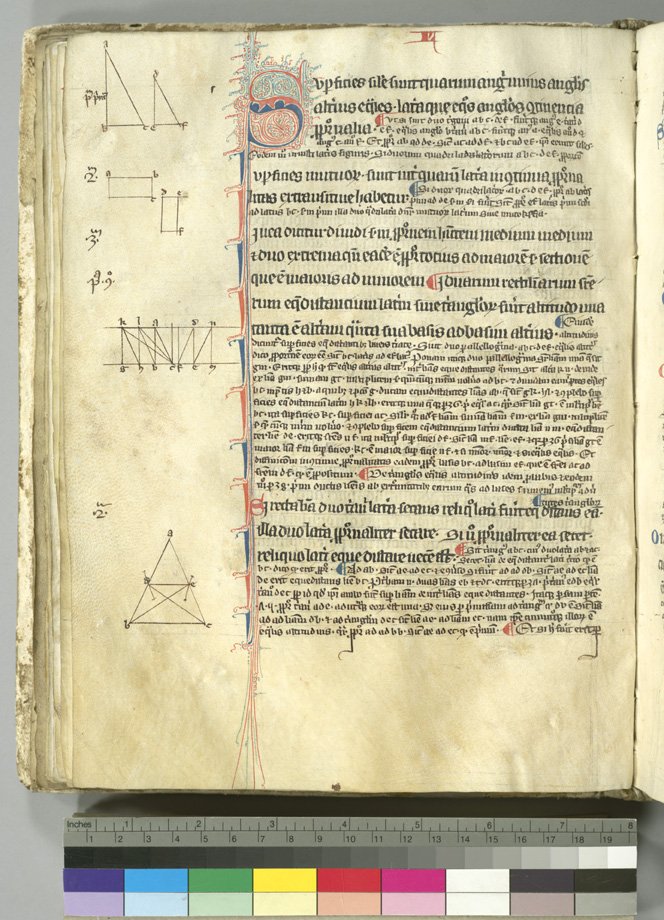- About MAA
- Membership
- MAA Publications
- Periodicals
- Blogs
- MAA Book Series
- MAA Press (an imprint of the AMS)
- MAA Notes
- MAA Reviews
- Mathematical Communication
- Information for Libraries
- Author Resources
- Advertise with MAA
- Meetings
- Competitions
- Programs
- Communities
- MAA Sections
- SIGMAA
- MAA Connect
- Students
- MAA Awards
- Awards Booklets
- Writing Awards
- Teaching Awards
- Service Awards
- Research Awards
- Lecture Awards
- Putnam Competition Individual and Team Winners
- D. E. Shaw Group AMC 8 Awards & Certificates
- Maryam Mirzakhani AMC 10 A Awards & Certificates
- Two Sigma AMC 10 B Awards & Certificates
- Jane Street AMC 12 A Awards & Certificates
- Akamai AMC 12 B Awards & Certificates
- High School Teachers
- News
You are here
Mathematical Treasures - Euclid's Elements in a manuscript from c. 1294

These pages are from Plimpton MS 165. This is a manuscript from c. 1294 that contains a copy of Boethius's Arithmetic followed by Euclid's Elements. (Pages from the Boethius are elsewhere in this document.) This page contains I-46 (On a given straight line to describe a square), I-47 (the Pythagorean Theorem) and I-48 (the converse of the Pythagorean Theorem). At the bottom of the page are the opening definitions of Book II. The diagrams, however, are not entirely in line with the propositions to which they refer. For example, the last diagram is one accompanying proposition II-1.

This page contains several propositions from Book III, dealing with properties of circles (propositions III-28, 29, 30, and 31). Note that the circles are all drawn with a compass and the straight lines with straightedges.

This is the first page of Book V, with the fancy letter at the top of the page. The text contains the various definitions of Book V dealing with ratio and proportion. The illustration in the right margin is of definition 5, the famous definition of equal ratio.

This page is the beginning of Book VI. Note the fancy initial letter desinating the beginning of a book. The two diagrams toward the top illustrate the definitions of similar figures. The text also includes propositions 1 and 2 of the book. Proposition 1 states that "triangles and parallelograms which are under the same height are to one another as their bases," while proposition 2 is "if a straight line is drawn parallel to one of the sides of a triangle, then it will cut the sides of the triangle proportionally, and conversely." The proof of proposition 1 is the only one in Book VI that makes explicit use of Euclid's definition 5 in Book V giving the definition of the equality of ratios.

On this page appears proposition 28 of Book VI (even though the number in the margin says "26"). The proposition, actually a construction, states, "To a given straight line to apply a parallelogram equal to a given rectilinear figure and deficient by a parallelogrammic figure similar to a given one; thus the given rectilineal figure must not be greater than the parallelogram described on the half of the straight line and similar to the defect." Note that in the accompanying diagram, the parallelogram is a rectangle and the given figure to which the defect is similar (labeled d) is a square. In this form, the problem can be translated (and was translated by Islamic mathematicians) into the question of solving a quadratic equation. Namely, if the given line segment has length b, if the given rectilinear figure (here a triangle) has area c, and if the length of the right hand segment of the line segment is labeled x, then the problem can be translated into the quadratic equation x(b - x) = c or bx - x2 = c.
Frank J. Swetz and Victor J. Katz, "Mathematical Treasures - Euclid's Elements in a manuscript from c. 1294," Convergence (January 2011)




